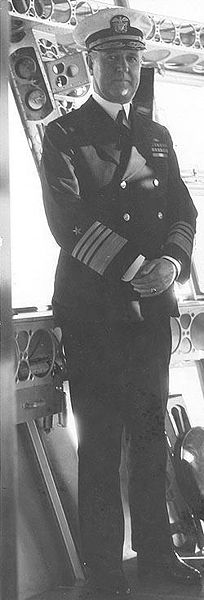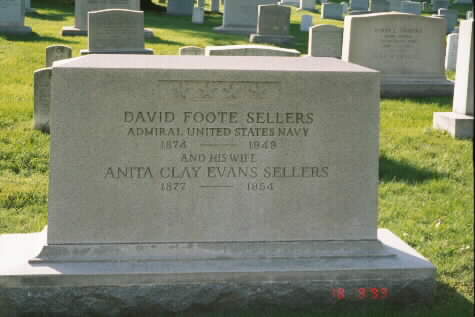Born February 4, 1874 in Austin, Texas, the son of a career Army officer. He graduted from the US Naval Academy in 1894 and was appointed an Ensign, July 1, 1896.
He served in the Spanish-American War, the Philippine Insurrection as well in operations in both Mexico and Nicaragua, receiving the Distinguished Service Medal (DSM) for the latter. He was the author of “Unofficial Navy Code,” in 1909.
For his World War I service he received the Navy Victory Medal with Star. Served as Superintendent of the Naval Academy from June 18, 1934 until his retirement in March 1, 1938.
In 1937, the right to a Bachelors’ Degree was extended backward to Naval Academy graduates before 1931. Only the Superintendent could sign the diploma, therefore Sellers, already a graduate of St. John’s College, and the University of Souther California, as well as the Naval Academy, had the odd distinction of signing his own sheepskin.
Following his death, he was buried in Section 26 of Arlington National Cemetery.
His wife, Anita Clay Evans Sellers, born at Chattanooga, Tennessee, and died on August 2, 1943 at Washington, D.C., is buried with him.
Courtesy of the United States Navy:
David Foote Sellers was born in Austin, Texas at an Army Post, on 4 February 1874, the son of Major Edwin E. Sellers and Mrs. (Olive Lay Foote) Sellers. He was appointed to the United States Naval Academy as a Naval Cadet from New Mexico and entered the Academy on 1 May 1890. Graduated on 8 June 1894, fifth in his class, he served the two years at sea then required by law, and was commissioned Ensign in the United States Navy on 1 July 1896. Through subsequent promotions, he attained the rank of Rear Admiral on 2 June 1927, held the temporary rank of Vice Admiral in 1932-1933, and that of Admiral in 1933-1934. After his retirement on 1 March 1938, he was commissioned in the grade of Admiral on the Retired List of the Navy effective 16 June 1942 (Act of Congress).
After graduation from the Naval Academy in 1894, he had continuous sea duty until May 1898, serving in USS MASSACHUSSETS, USS ESSEX and USS ALLIANCE. On 24 May 1898, he reported to the Receiving Ship INDEPENDENCE, and when detached on 9 July, reported aboard USS PHILADELPHIA, in which he served during the Spanish-American War. He took part in the Samoan Campaign in 1899, and was in Philippine waters during the Philippine Insurrection, on board USS NEW YORK, while serving in the staff of Rear Admiral Frederick Rodgers. Detached from duty aboard NEW YORK in October 1904, he assumed command of the Torpedo Boat Destroyer STEWART, serving as Commanding Officer until May 1907.
Serving next in the Bureau of Navigation of the Navy Department in Washington, D.C., he had additional duty as Naval Aide to the White House, serving until June 1908. Later that month, he joined the crew of USS NEW HAMPSHIRE, to serve as Aide on the staff of Rear Admiral William S. Cowles, Commander in Chief, Asiatic Fleet. He was detached from this duty by orders dated 30 November 1909, and after duty in connection with the fitting out of USS MICHIGAN at the Navy Yard in Philadelphia, Pennsylvania, served in that Battleship from her commissioning in 1910 until he was detached on 16 May 1912.
Reporting to Hampton Roads, Virginia, he served temporarily as Aide to the Commander of a Division of German ships which was visiting the United States at that time, and on 9 July was sent to San Francisco for duty in connection with the Panama Pacific International Exposition. From 4 February 1914 until 19 May 1915, he served as Executive Officer of USS ARKANSAS, then successively commanded USS SALEM and USS BIRMINGHAM, completing his tour of BIRMINGHAM on 9 June 1916. He attended the Naval War College in Newport, Rhode Island during the next nine months, and on 23 April 1917, just after the United States entered World War I, he was detached to command of USS AGAMEMNON, an Atlantic Fleet transport ship, remaining in command through the last months of hostilities.
He was awarded the Navy Cross for service during World War I, the award accompanied by the following citation: “For exceptionally meritorious service in a duty of great responsibility as Commanding Officer, USS AGAMEMNON, engaged in the important, exacting and hazardous duty of transporting troops and supplies to European ports through waters infested with enemy submarines and mines, and as Commanding Officer, USS WISCONSIN in the Atlantic Fleet…”
After the War, he served for a year on the staff of the Naval War College, then on 12 April 1920, was ordered to the Navy Department for a second tour of duty in the Bureau of Navigation. While there, he also served as Aide to the Secretary of the Navy, the Honorable Edwin Denby, from 30 September 1921 until 28 February 1922. On 1 March he assumed command of USS MARYLAND. Upon completion of that tour in command, he reported as Commander of the Naval Training Station in San Diego, California. Completing that tour in September 1926, he then reported as Chief of Staff to the Commander, Scouting Fleet, continuing in that duty until he was promoted to the grade of Rear Admiral on 2 June 1927.
On 8 July 1927, he was assigned as Commander, Special Service Squadron. He served in that capacity until May 1929, during the uprisings in Nicaragua. He was awarded the Distinguished Service Medal by the President of the United States with the following citation: “For exceptionally meritorious service to the Government in a position of great responsibility as Commander, Special Service Squadron from 8 July 1927 to 12 May 1929 during the disturbed conditions in the Republic of Nicaragua. Throughout this time, Rear Admiral Sellers handled with great skill and diplomacy the many delicate situations which arose incident to the pacification of Nicaragua prior to the presidential election on 4 November 1929, during the election and subsequent to it. As the Senior Officer Present, he coordinated the activities of the Marine Brigade on shore, which was a part of his command, with the activities of the Nicaraguan Government, the Guardia National and the officers of the United States Army on election duty. In the discharge of his duty of protecting lives and property, he displayed strength and initiative coupled with wisdom and tempered by kindness and humanity.”
In June 1929, he was appointed Judge Advocate General of the Navy for a four year term, but on 1 August 1931, was instead ordered to report on 15 September as Commander Battleship Division ONE, Battle Force, U.S. Fleet. A year later, he was designated Commander Battleships, Battle Force, with the accompanying rank of Vice Admiral; and on 10 June 1933, he became Commander in Chief. United States Fleet with the rank of Admiral. He served as Commander in Chief until 18 June 1934 when he reported as Superintendent of the Naval Academy, in which capacity he served until his retirement from active duty on 1 March 1938.
Retired in his permanent grade of Rear Admiral, he was advanced to the grade of Admiral on the Retired List on 16 July 1942, according to the Act of Congress of that date. That Act allowed an officer to retire in the highest grade in which he served on active duty. Admiral Sellers died at the Naval Hospital, Bethesda, Maryland, on 27 January 1949; and was buried at Arlington National Cemetery. He was survived by his wife, the former Anita Clay Evans of Chattanooga, Tennessee, who resided in Washington, D.C. until her death there on 2 August 1954.
In addition to awards of the Navy Cross and the Distinguished Service Medal, Admiral Sellers had been awarded a Special Letter of Commendation by the War Department for service during World War I, and was awarded the Spanish Campaign Medal, Philippine Campaign Medal, Mexican Service Medal, Second Nicaraguan Campaign Medal, and World War I Victory Medal with Transport Clasp. He also had been awarded the Marine Corps Expeditionary Medal for service as a member of the Landing Force from USS PHILADELPHIA during the Samoan Insurrection from 14 March until 18 May 1899. Admiral Sellers wore the following foreign decorations: Gold Medal of Merit and the Medal of Merit, both from the government of Nicaragua; and the Order of Abdon Calderon from the government of Equador.
Admiral Sellers was staunch advocate of battle training under realistic conditions, and of the Navy air arm. He insisted on the most modern flight equipment, and recognized the importance of air power in strategic planning. Following his retirement from active duty, he was known for the active interest he took in civic, welfare and church affairs. He was a long-time member of the Board of Directors of Children’s Hospital in Washington, D.C., the city in which he and his wife maintained a home for almost fifty years.
SELLERS, DAVID FOOTE
- ADM USN
- DATE OF BIRTH: 02/04/1894
- DATE OF DEATH: 01/27/1949
- BURIED AT: SECTION 2 SITE 4960-A S
- ARLINGTON NATIONAL CEMETERY
SELLERS, ANITA CLAY W/O DAVID FOOTE
- DATE OF BIRTH: 09/05/1881
- DATE OF DEATH: 08/02/1954
- BURIED AT: SECTION 2 SITE 4960-A N
- ARLINGTON NATIONAL CEMETERY
Michael Robert Patterson was born in Arlington and is the son of a former officer of the US Army. So it was no wonder that sooner or later his interests drew him to American history and especially to American military history. Many of his articles can be found on renowned portals like the New York Times, Washingtonpost or Wikipedia.
Reviewed by: Michael Howard


